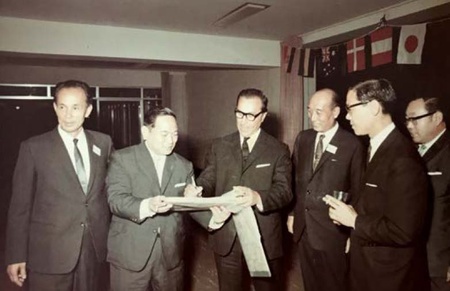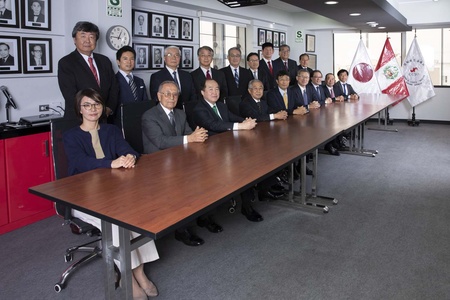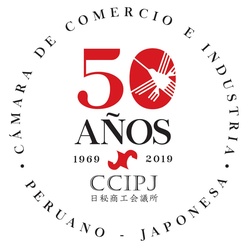The first 790 Japanese who arrived in Peru in 1899 to work on coastal haciendas were covered by four-year contracts. None of them, nor the thousands of hires who arrived later, had the intention of putting down roots in Peru.
If everything had gone according to plan, in 1969—70 years after the start of Japanese immigration—probably no traces of the Japanese presence would have been found in Peru.
However, at the end of the 1960s there was a large and well-established Nikkei community in Peru.
After suffering abuses (looting, theft of property, closure of institutions and schools, etc.) during the Second World War for being from a country that was an enemy of the United States, the Issei decided to settle permanently in Peru. The community recovered during the postwar period and many prospered, including businessmen such as Carlos Chiyoteru Hiraoka.
In 1969, a group of Japanese immigrant business owners and executives of Japanese companies based in Peru created the Japanese Peruvian Chamber of Commerce and Industry (CCIPJ).

In 2019, the institution celebrated its 50th anniversary. This year, in the midst of the coronavirus pandemic, the Chamber published a commemorative book that documents its half-century history and projects itself into the future as a commercial, human and cultural bridge between Peru and Japan.
NIKKEI, JAPANESE AND THE SPIRIT OF HARMONY
When the CCIPJ was founded, there was no internet and television broadcast black and white images. The executives of Japanese companies in Peru, assigned to a country very different from their own in customs and culture, needed information in their language and, especially, guidance in all areas of things, not only in the economic aspect. To understand, adapt and do their work in Peru they also required help on the social, political, legal, etc. level. The Issei businessmen, fully inserted in Peruvian society, became their guides.
For the immigrants, the interaction with Japanese executives was also fruitful, since they were their link with modern Japan, the country that was rebuilding after two atomic bombs and emerging as a world power, distant from the prewar Japan that they had emigrated in search of job opportunities.
The Chamber was born in a difficult situation. A nationalist and anti-market military dictatorship ruled in Peru. It was not a climate conducive to the formation of a business institution with foreign members, but the idea had germinated years ago, when the country was living in democracy.
Adversity did not stop the promoters of the Chamber and they even managed to get three ministers of State to attend the inauguration of their office at the Peruvian Japanese Cultural Center, among them the Minister of Economy, Francisco Morales Bermúdez, who years later would become president of Peru.
The CCIPJ was formed with 66 companies: 27 Japanese and 39 Nikkei. Its first president was the general manager of the Lima branch of the Bank of Tokyo, Tsukasa Kimura. From then until today, the presidency of the institution is occupied by a Japanese, while the first vice presidency corresponds to a Peruvian.
During its more than 50 years of existence, the Chamber has had to overcome great obstacles to stay alive; In a country as unstable as Peru, marked by constant crises, that is almost equivalent to a feat.

Due to its business nature, its destiny is closely linked to the political and economic situation of the country. Thus, since its founding it has survived dictatorships, economic disasters and terrorism. In the 1980s, a Japanese executive was the victim of a terrorist attack and in the 1990s, several CCIPJ executives were held hostage by an extremist group at the residence of the Japanese ambassador in Lima. In both cases, luckily the victims survived.
The situation reached such an extreme during the time of armed subversion that the majority of presidents of Japanese companies traveled in armored cars and, in order not to attract attention, the Chamber advised Japanese executives to take off their hats when leaving their offices. jackets and ties.
In the last 20 years, despite political ups and downs, Peru has enjoyed economic stability that has favored the functioning of the Chamber. However, today, like the entire planet, it faces an unprecedented crisis: the coronavirus.
However, if it has managed to overcome half a century of crises of all kinds, it will also overcome the current one. The example of the pioneers shows the way to follow. As Tatsuya Shimizu, a Japanese executive who has been part of the CCIPJ almost since its inception, points out in the book published on the occasion of its 50th anniversary: “We must not forget the principle and spirit of its foundation that the founders, former presidents and former directors bequeathed to us. In the past, our Chamber has overcome various difficulties and dark times, precisely thanks to the unity among the members and the spirit of 'wa' (harmony)."
“PRICELESS CONTRIBUTION”
The CCIPJ continues to work to promote trade relations between Peru and Japan, as well as supporting its associates with information and guidance on economic and legal matters, business opportunities, etc.
The Chamber is divided into three committees (improving the business environment, industry and communications) and organizes conferences by experts on topics such as mining, economic prospects, trade exchanges and the environment, among others.
The CCPIJ board is made up of 18 directors: nine Japanese and nine Peruvian. Both parties contribute diverse knowledge and experiences that come together for the benefit of the institution. While the Japanese, executives with a short stay in Peru, contribute with their global vision and new approaches, the Peruvians, with roots in the country and with a long stay in the Chamber, guarantee stability and the maintenance of basic principles.
In 2019, on the occasion of its 50th anniversary, the institution organized an economic forum focused on relations between Peru and Japan, which included the participation of senior officials of the Peruvian government, specialists in various areas, and the then Japanese Prime Minister, Shinzo Abe.
In a message sent by video, Abe highlighted the trajectory of the Chamber and its contribution to strengthening ties between Peru and Japan: “I wish to express my deep gratitude to the Peruvian-Japanese Chamber of Commerce and Industry, which over 50 years "It has promoted economic relations and exchanges in numerous fields between our two countries, having made an invaluable contribution to the development of bilateral relations."
© 2020 Enrique Higa






